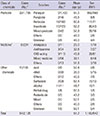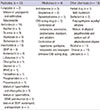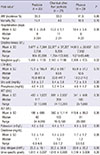1. Allison RC, Bedsole DL. The other medical causes of rhabdomyolysis. Am J Med Sci. 2003; 326:79–88.
2. Law M, Rudnicka AR. Statin safety: a systematic review. Am J Cardiol. 2006; 97:52C–60C.
3. Wu J, Song Y, Li H, Chen J. Rhabdomyolysis associated with fibrate therapy: review of 76 published cases and a new case report. Eur J Clin Pharmacol. 2009; 65:1169–1174.
4. Hadad E, Weinbroum AA, Ben-Abraham R. Drug-induced hyperthermia and muscle rigidity: a practical approach. Eur J Emerg Med. 2003; 10:149–154.
5. Tritakarn T, Teeratchanan T. Acute rhabdomyolysis and cardiac arrest following succinylcholine in a patient with Parry-Romberg syndrome. Anaesth Intensive Care. 2011; 39:135–136.
6. Riggs JE. Alcohol-associated rhabdomyolysis: ethanol induction of cytochrome P450 may potentiate myotoxicity. Clin Neuropharmacol. 1998; 21:363–364.
7. Richards JR. Rhabdomyolysis and drugs of abuse. J Emerg Med. 2000; 19:51–56.
8. Propst A, Propst T, Feichtinger H, Judmaier G, Willeit J, Vogel W. Copper-induced acute rhabdomyolysis in Wilson's disease. Gastroenterology. 1995; 108:885–887.
9. Mastaglia FL, Needham M. Update on toxic myopathies. Curr Neurol Neurosci Rep. 2012; 12:54–61.
10. Sitprija V. Animal toxins and the kidney. Nat Clin Pract Nephrol. 2008; 4:616–627.
11. Weng SF, Hung DZ, Hu SY, Tsan YT, Wang LM. Rhabdomyolysis from an intramuscular injection of glyphosate-surfactant herbicide. Clin Toxicol (Phila). 2008; 46:890–891.
12. Horowitz BZ, Marquardt K, Swenson E. Calcium polysulfide overdose: a report of two cases. J Toxicol Clin Toxicol. 1997; 35:299–303.
13. Meulenbelt J, Zwaveling JH, van Zoonen P, Notermans NC. Acute MCPP intoxication: report of two cases. Hum Toxicol. 1988; 7:289–292.
14. Roberts DM, Seneviratne R, Mohammed F, Patel R, Senarathna L, Hittarage A, Buckley NA, Dawson AH, Eddleston M. Intentional self-poisoning with the chlorophenoxy herbicide 4-chloro-2-methylphenoxyacetic acid (MCPA). Ann Emerg Med. 2005; 46:275–284.
15. Hong JR, Seok SJ, Jeong DS, Lee SG, Gil HW, Yang JO, Lee EY, Hong SY. Association of the superoxide dismutase (V16A) and catalase (C262T) genetic polymorphisms with the clinical outcome of patients with acute paraquat intoxication. Korean J Intern Med. 2010; 25:422–428.
16. Seok SJ, Gil HW, Jeong DS, Yang JO, Lee EY, Hong SY. Paraquat intoxication in subjects who attempt suicide: why they chose paraquat. Korean J Intern Med. 2009; 24:247–251.
17. Englberger L, Suri RM, Li Z, Casey ET, Daly RC, Dearani JA, Schaff HV. Clinical accuracy of RIFLE and Acute Kidney Injury Network (AKIN) criteria for acute kidney injury in patients undergoing cardiac surgery. Crit Care. 2011; 15:R16.
18. Floyd JS, Heckbert SR, Weiss NS, Carrell DS, Psaty BM. Use of administrative data to estimate the incidence of statin-related rhabdomyolysis. JAMA. 2012; 307:1580–1582.
19. Hill OT, Wahi MM, Carter R 3rd, Kay AB, McKinnon CJ, Wallace RF. Rhabdomyolysis in the US Active Duty Army, 2004-2006. Med Sci Sports Exerc. 2012; 44:442–449.
20. Song HY, Kim YH, Seok SJ, Gil HW, Yang JO, Lee EY, Hong SY. Cellular toxicity of surfactants used as herbicide additives. J Korean Med Sci. 2012; 27:3–9.
21. Song HY, Kim YH, Seok SJ, Gil HW, Hong SY. In vitro cytotoxic effect of glyphosate mixture containing surfactants. J Korean Med Sci. 2012; 27:711–715.
22. Heyne N, Guthoff M, Krieger J, Haap M, Häring HU. High cut-off renal replacement therapy for removal of myoglobin in severe rhabdomyolysis and acute kidney injury: a case series. Nephron Clin Pract. 2012; 121:c159–c164.










 PDF
PDF ePub
ePub Citation
Citation Print
Print


 XML Download
XML Download